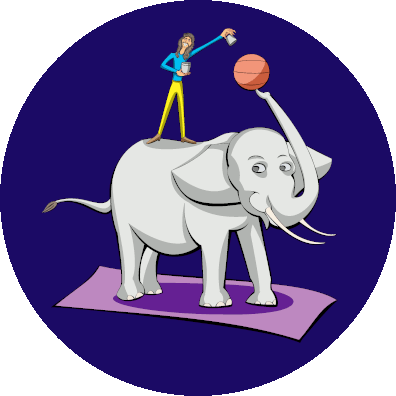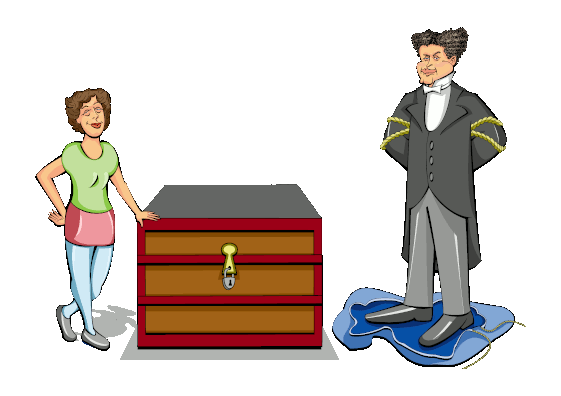Doug Henning

(Click on the image to zoom in and out.)
Doug Henning certainly broke the mold of the "professor" of magic. Forget the white tie and tails with the top hat and white gloves.1 Doug would come on stage sans chapeau wearing t-shirt and chino trousers and sporting the (for the time) stylishly long "hippie" hair.2
Footnote
For those of a particularly tender vintage - ergo, they weren't around more than half a century ago - we can quote the Random House Webster's Concise Dictionary (Random House, 1996):
hip-pie: (hip'ē), n., pl. -pies. a young person of the 1960s who rejected established social values and wore long hair and unconventional clothes.
Although this is a rather superficial definition, it'll do for now.
But if there is any one person who brought on the sudden and unexpected rise of stage magic after its long and tortuous decline through the mid-20th Century, that had to be Doug. Today we see top magicians performing to sellout crowds in Las Vegas and starring in mega-extravaganza television specials. But if you look for magicians who were starring in the really big shows before Doug came along, you'll be hard pressed for names.
Of course, magic aficionados may object. What about Dai Vernon, one of the greatest sleight of hand artists of the 20th century? And Harry Blackstone, Sr., began performing in the Golden Age of Magic and continued well into the 1950's. And don't forget that James Randi appeared regularly on television as did English magician Paul Daniels who was a constant presence on the BBC.

Harry Blackstone
Into the 1950's
It's not to deny that there were skilled conjurers in the first thirty post-war years. But none of them had shows like Doug Henning's World of Magic which was broadcast live in 1975 and was viewed by 50 million people. It's been pointed out that more people watched Doug in that one hour special than saw Harry Houdini during his entire lifetime. Naturally Doug appeared as a guest on the top television programs: The Tonight Show with Johnny Carson, The Mike Douglas Show, not to mention Captain Kangaroo, and ultimately achieving the height of true fame when he hosted an episode of The Muppet Show.
When Doug was a guest on the various television programs he would do a lot of close-up magic with handkerchiefs, ropes, cards, cups, and balls. Much was standard magic fare like cutting a rope in two and restoring it. Of course, Doug performed with high skill and flair. The Cups and Balls Trick is one where the balls seem to move around beneath inverted cups and then change into larger objects (Doug had them change into an onion). Moving the balls around is something any beginning magician can learn quickly but making the balls change into onions or baseballs requires considerable prestidigitational skills.
But on his own shows Doug went in for big tricks including a number first made famous by Harry Houdini. Doug performed the Water Cell Torture Escape, Metamorphosis, and yes, Doug even Vanished an Elephant. In all cases he improved on Harry's performance.
For instance, Harry vanished an elephant by having it led into a large wheeled box. He closed the door and after a moment the (narrow) door was reopened, and the few in the audience who could see inside saw no elephant. Some in the audience noted it took three men to wheel the box on stage but twenty men had to wheel it off. Doug dispensed with the box and just had the elephant walk on stage and disappear surrounded by a curtain - while Doug stood on the elephant's back.
In Metamorphosis - also called the "Trunk Substitution Trick" - Doug would handcuff an assistant and then put her in a large bag which was then tied shut. The bagged-up assistant was placed in a trunk which was then locked and chained. Doug would then stand on top of the trunk and hold up a curtain. In the next second the curtain would drop, revealing not Doug, but the assistant free of bags and bonds. Once she unlocked the trunk and opened the bag, there would be Doug.

Harry and Bess Houdini
Metamorphosis
(Doug did it faster.)
This is the way the trick is usually performed today. That is, the assistant goes into the trunk to be replaced by the magician. But Houdini did it in reverse. His assistant - his wife, Bess - would handcuff Harry and put him in the bag and trunk. Then Harry would get out and be replaced by Bess.
Doug said that the reason most magicians did the trick like he, Doug, did was because the applause would coincide with the reappearance of the magician - ergo, the star of the show. On the other hand, Harry was primarily an escape artist. So it made sense for Harry to do the escaping.
Doug had another addition for the trick. When he was released, he sported a change of clothes.
Doug also performed Harry's famous (and dangerous) Water Cell Escape.3 Here the magician is locked by his ankles to the lid of a water filled cabinet and lowered down head first. A curtain goes around the cabinet and as a clock ticks off the time the magician finally appears, drenched and soaked but sound and alive. Even though the audience knows there's a trick to it, it's also clear that if something goes wrong the magician can be in trouble.
Footnote
Harry sometimes billed this trick as the somewhat more pejoratively named "Chinese Torture Trick" where the poster blared "Failure Means a Drowning Death!" Privately Harry referred to the trick as the "Upside Down".
Sometimes for the big tricks, though, it's relatively easy to guess the general modus magicerandi if not the fine details. For instance, in Doug's Vanishing Motorcycle Rider, he and the crew set up some walls around a platform to create a large box at center stage. Doug then gets onto a motorcycle and drives into a cage next to the box. The cage, with Doug on the cycle still visible, is lifted high off the stage while the empty box is lifted up as well. Then the bottom drops out of the cage and Doug and the motorcycle suddenly vanish. Immediately the walls of the box fall away revealing Doug and the motorcycle instantaneously transported. The platform is lowered and Doug drives onto the stage to thunderous applause.
Without being told the actual secret, the viewer might note some points. First, although the platform is raised, you can't actually see very far underneath. And once the walls are set up, you can't see what's behind the platform either.
Next while everyone is setting up the walls, Doug lowers the visor of the helmet and so obscures his face. He then walks behind the rearmost wall and briefly disappears from view. After a few seconds "Doug" (note quotes) reappears and gets on the motorcycle and drives into the cage.
Crucial to the trick is that the background on stage where Doug is lifted up is completely black unlike the rest of the backdrop which has a starry design. And if you look carefully when Doug vanishes, there is a decidedly less than three dimensional look through the bars toward the "back curtain".
It's also worth noting that all the while the trick is underway, Doug is "assisted" by a dance troupe composed mostly of comely young ladies in hot pants plus a couple of hunky beefcakes. In magic, distraction and misdirection are always important.
Obviously television magic has some drawbacks. Even if the original show was live, there will certainly be tapes made. So nowadays it's possible for a viewer to replay the trick.
Which has the effect of violating one cardinal rule of magic performances. Never do a trick before an audience more than once. Even if you do it just twice, the audience knows what to expect and might see clues they missed before. But with today's ready availability of videos, a trick can be seen many times over.
Another oft stated rule has been that television magicians should not achieve their effects by trick photography, which today is usually computer-generated imagery (CGI). What you see on the tube is supposed to be what you would see if you were right there with the audience. Although this stipulation hasn't always been followed scrupulously - as early as the 1960's a famous television magician used a split screen technique to make it look like his legs had separated from his body - many magicians, including Doug, have adhered to this rule.
But more recently there has been a modification of this criteria to where a trick is considered OK if a live viewer would see the trick as limited by the perspective and range of the camera. Given that the camera view is often restricted and the angle far from wide, tricks that work only on television are becoming more common. Camera "pans" can also be used to help accomplish seemingly impossible tricks. If a camera briefly points in one direction, a lot can happen just off to the side.
Another rule that seemingly has been relaxed is the number of stooges the magician can employ. Certainly having a "confederate" (a somewhat more polite word) posing as an audience member but who actually helps with the trick is a well accepted practice. Traditionally one stooge is acceptable for the odd trick or so, and maybe two can be used in a pinch.
But the use of stooges can move beyond the bounds of good taste. For instance, it's common for the magician to have a delegation from the audience come on stage to view a trick up close. The committee may examine various apparati to show there is no obvious trickery or they may surround a closed cabinet or curtained off area to show that off stage assistance isn't possible.
But if everyone who "volunteers" is actually a stooge (sorry, that's "confederate") while the real audience only sees the trick from one direction (or through a television camera), seemingly miraculous tricks become routine. With this "all the world's a stooge" approach, almost anything can be made to appear or disappear by simply moving it on or off stage via a route blocked from the audience - but easily seen by the stooges. A most lamentable development in the World of Magic!4
Footnote
One magician even admitted he was contemplating achieving one of the Amazing Building Disappearances by having the audience sit in a restaurant. He would then put a wide screen television on a wall but disguised as a window. Obviously the "building vanish" would then be trivially simplistic. The magician abandoned that approach when he realized that the audience would probably run outside to get a closer look.
References
"Doug Henning", Magicpedia.
"Doug Henning", Internet Movie Data Base.
Houdini: His Legend and His Magic, Doug Henning (with Charles Reynolds), Warner Books.